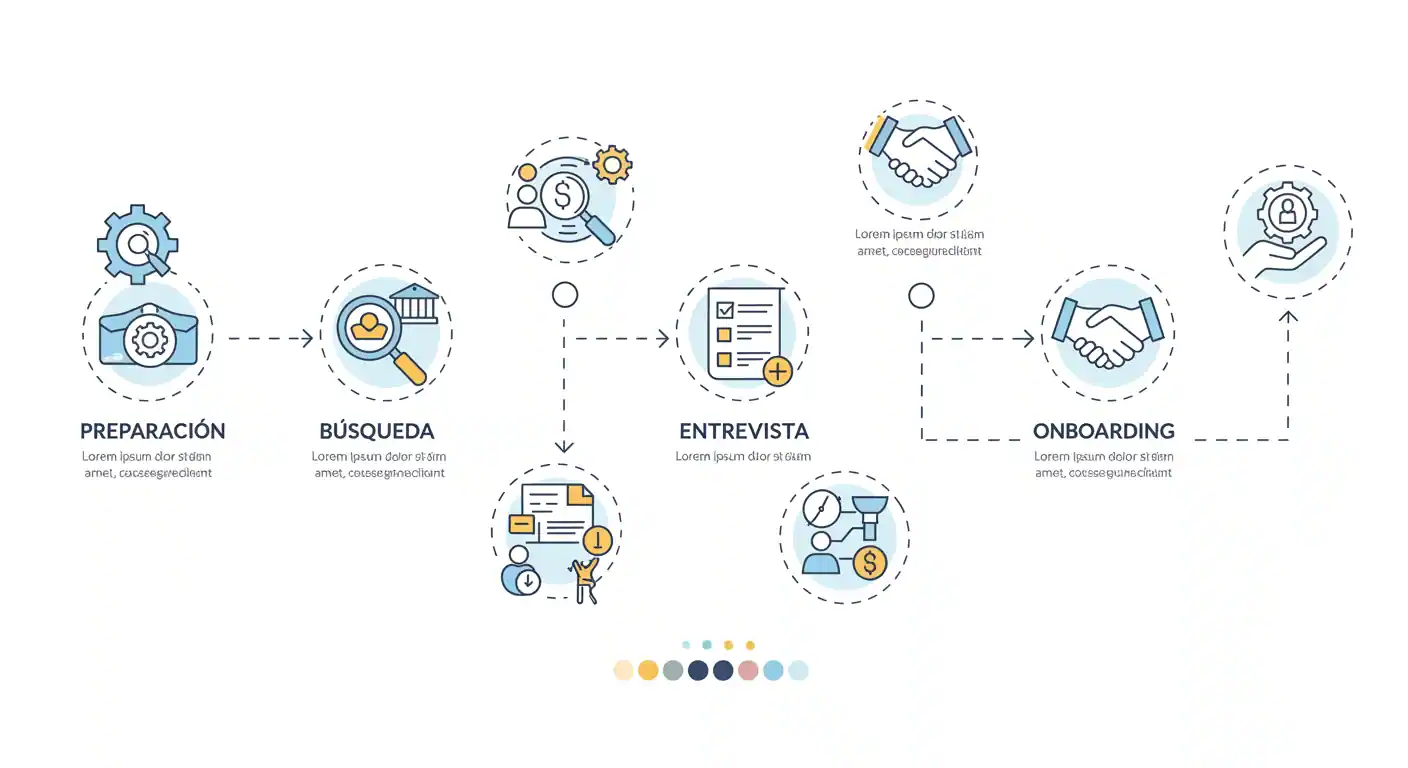How to Hire Your First Employee: The Ultimate Guide from Job Posting to Onboarding
Overcome the fear and uncertainty. Navigate the legal, financial, and human complexities of your first hire with confidence and get it right from day one.
Making the leap from “entrepreneur” to “employer” is perhaps the most nerve-wracking yet transformative decision you’ll make in your business journey. This isn’t just about adding a line item to your budget—it’s about entrusting part of your dream to another person.
If fear of making the wrong choice, lack of HR knowledge, or simply not knowing where to start has you paralyzed, take a deep breath. You’re in the right place.
At MiNegocioTop.com, we’ve been through this process ourselves. This isn’t theoretical advice from an HR textbook. This is your practical roadmap, complete with checklists and common-sense guidance that will take you from asking “Can I afford this?” to watching your new team member thrive on day one—ensuring every step is solid, compliant, and strategic.

The pivotal moment: building trust and connection from the first interview
The Diagnosis: “Solopreneur Syndrome” and the Fear of Letting Go
Recognizing the root problem is your first step to solving it for good.
Hiring isn’t just a process—it’s a psychological barrier. If this resonates with you, you’re not alone. This is the conversation happening in every small business Facebook group and entrepreneur forum across America.
???? The Financial Vertigo
The question isn’t “What will I pay them?” but “What’s the total cost of bringing someone on board?” Payroll taxes, workers’ comp, benefits, equipment, training time… Not knowing these “hidden costs” is the #1 reason small business owners freeze up.
???? The “Wrong Hire” Terror
The panic of investing time and money in someone who doesn’t perform, has attitude problems, or simply isn’t competent. “What if I have to fire them? Will they sue me? What about unemployment claims?”
???? The Control Addiction
“Nobody will do it like I do it” is the belief that delegating means losing quality or control. This bottleneck is what keeps 90% of small businesses from scaling beyond the owner’s personal capacity.
Your Hiring Roadmap: 5 Phases to Hire Like a Pro
A systematic approach that eliminates guesswork and maximizes your chances of success.

Your complete roadmap: from preparation to successful onboarding
Phase 1: Strategic Preparation (Where 70% of Success Happens)
Don’t hire a person—hire the solution to a specific business problem.
Define the Role, Not the Person
What exact tasks do you need to delegate? Make a brutally honest list of everything stealing your time and preventing you from working on your business instead of in it. This becomes your job description foundation.
???? Pro Tip for US Small Business Owners:
Track your time for one week using tools like Toggl or RescueTime. You’ll be shocked at where your hours actually go. The tasks you do most reluctantly or that take you away from revenue-generating activities? Those are prime candidates for delegation.
Calculate Your True Cost of Employment (TCE)
Meet with a CPA or HR consultant and ask: “If I want to pay someone $X per hour, what’s my total all-in cost including payroll taxes, workers’ comp, benefits, and equipment?” In the US, expect to add 25-40% on top of gross wages. This number—not the hourly wage—needs to fit your budget.
Write a Job Posting That Attracts A-Players
Stop posting task lists. Sell your mission and opportunity. Talk about your company culture, growth potential, and the impact this role will have. Use location-specific keywords like “marketing assistant Denver startup” or “administrative support small business Austin.
Phase 2: Smart Sourcing Strategy
Your ideal candidate might not be actively job hunting—but they’re findable.
Traditional Job Boards
Indeed, LinkedIn, Glassdoor are your obvious starting points. But don’t stop there.
Your Network (The Secret Weapon)
Post the opportunity on your personal LinkedIn, Facebook, and Instagram. Ask your business contacts, chamber of commerce connections, and fellow entrepreneurs to share. Employee referrals consistently produce the best hires and have the lowest turnover rates.
Industry-Specific Communities
Search Facebook groups like “Marketing Professionals [Your City]” or LinkedIn groups for your industry. Local college job boards and professional association websites are goldmines for finding quality candidates.
???? US-Specific Sourcing Hack:
Post in local Facebook groups like “[Your City] Jobs” or “[Your State] Remote Work Opportunities.” Many quality candidates browse these community boards before checking traditional job sites.
Phase 3: The Interview That Reveals True Potential
Stop asking the same old questions and start getting the insights you actually need.
Behavioral Interview Questions (The Game-Changer)
Instead of “Do you know how to use QuickBooks?” ask: “Tell me about a time you had to learn a new software system quickly to solve a business problem. Walk me through your process.” You want evidence of past behavior, not future promises.
Skills Assessment (Non-Negotiable)
Give them a small, paid project that mirrors real work. For a social media manager, ask for 5 sample posts for your business. For an admin role, request a simple spreadsheet task. Seeing their actual work beats any resume.
The Culture Fit Question
Ask: “What do you need from a manager to do your best work?” This reveals their work style, communication preferences, and whether they’ll thrive in your environment.
???? Legal Interview Tip for US Employers:
Avoid questions about age, marital status, pregnancy, religion, or national origin. Stick to job-related questions. When in doubt, ask: “Is this directly related to their ability to perform this role?”
Phase 4: The Offer and Legal Paperwork
Where clarity and professional guidance save you from costly mistakes down the road.
Written Job Offer
Before any contracts, send a clear email offer including: position title, key responsibilities, starting salary/hourly rate, start date, and any probationary period. This protects both parties.
Essential US Employment Forms
Your new hire must complete Form I-9 (employment eligibility) and Form W-4 (tax withholding) before their first day. No exceptions—this is federal law.
Consider Using HR Software
Gusto, BambooHR, or Rippling can handle your payroll, tax filings, and compliance automatically. For most small businesses, this $40-100/month investment pays for itself in time saved and mistakes avoided.
⚠️ At-Will Employment Reminder
In most US states, employment is “at-will,” meaning you can terminate for any reason (that’s not illegal discrimination) or no reason at all. However, document performance issues and follow consistent policies to protect yourself from wrongful termination claims.
Phase 5: Onboarding for Success (The First 90 Days)
Your hire’s success is determined here. Don’t leave them to figure it out alone.
Prepare Their Arrival
Have their email set up, system access ready, workspace prepared, and first-day schedule planned before they walk in. Nothing says “amateur operation” like scrambling to find them a computer on day one.
The First Week Game Plan
Create a simple document outlining their week 1 objectives, key people they’ll meet, resources they should study, and small wins they can achieve quickly. Early success builds confidence and momentum.
Regular Check-ins Are Critical
Daily 10-minute conversations for the first week, then weekly 30-minute one-on-ones for the first month. Consistent feedback prevents small problems from becoming big ones.
???? Employee Handbook Best Practice:
Even small businesses benefit from a basic employee handbook covering your policies on PTO, sick leave, remote work, and performance expectations. Templates are available through SCORE mentors or your local SBDC for free.
State-Specific Legal Essentials: What Every US Small Business Owner Must Know
Employment law varies significantly by state. Here’s what matters most in key business markets.
⚠️ Important Legal Disclaimer
This is general guidance only. Always consult with an employment attorney or HR professional familiar with your state’s specific requirements before making hiring decisions.

Professional guidance is essential for navigating employment law complexities
???? California: Employee-Friendly Laws & High Compliance Requirements
Key Challenge: Complex Labor Laws
California has some of the most employee-protective laws in the nation. Meal and rest break requirements, overtime calculations, and sick leave mandates are strictly enforced with hefty penalties for violations.
Critical Requirement: Classification Accuracy
The ABC Test for independent contractors is extremely strict. Unless someone truly operates independently, they’re likely an employee with full benefits and protections.
Smart Business Practice
Invest in California-specific HR software like Gusto or ADP that automatically handles state-specific requirements. The cost of non-compliance far exceeds the software expense.
???? Texas: Business-Friendly Environment with Federal Focus
Advantage: Right-to-Work State
Texas follows federal employment standards without many additional state requirements. At-will employment is strongly protected, giving employers flexibility in hiring and termination decisions.
Key Consideration: Workers’ Compensation
Unlike most states, Texas doesn’t require workers’ comp insurance, but you’re liable for workplace injuries without it. Many small businesses choose to purchase coverage anyway for protection.
Growth Opportunity
Texas offers numerous small business resources through SCORE, SBDC centers, and local chambers of commerce that provide free HR guidance and templates.
???? New York: Progressive Policies & Detailed Requirements
Critical Compliance: Paid Family Leave
New York requires paid family leave, disability insurance, and specific wage notice requirements. Employees must receive written wage notices in English and their primary language if available.
NYC-Specific Rules
New York City has additional requirements including fair workweek laws for retail, salary history bans, and specific sick leave provisions beyond state minimums.
Professional Recommendation
Given the complexity, most NY small businesses benefit from working with a local employment attorney or PEO (Professional Employer Organization) for compliance support.
???? Florida: Straightforward Approach with Federal Standards
Business Advantage: Minimal State Requirements
Florida generally follows federal employment standards without additional state mandates. No state income tax simplifies payroll processing compared to many other states.
Workers’ Compensation Focus
Florida requires workers’ comp coverage for most businesses with employees. Construction companies need coverage with just one employee, while other industries typically require coverage with four or more employees.
Growth Resources
Florida SBDC centers and Enterprise Florida offer excellent free resources for small business hiring and HR best practices.
Your First Hire: The Decision That Transforms Your Business Forever
Remember: hiring your first employee isn’t just a business transaction—it’s the moment your side hustle becomes a real company. Do it right from the start, and you’ll build the foundation for an exceptional team that drives your success for years to come.
